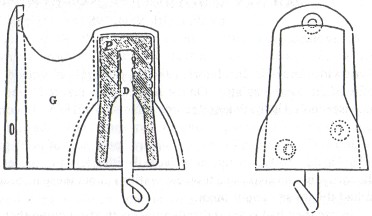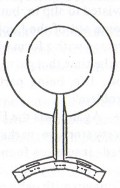Foreign Insulators
by Marilyn Albers
Reprinted from "Crown Jewels of the Wire", October 1994, page 13
U-1966, "THE PERFECT INSULATOR"
This unique insulator made its appearance at the Silver Anniversary National
Show held in Houston July 1-3,1994. It's not the sort of thing that would be
attractive to the average collector because its iron-clad body is an ugly gray,
and the iron hook prevents it from standing up by itself, so it is difficult to
display. But let me tell you, this grand old gentleman has a definite place in
the history of telegraphy . It is old and it is one of the rarest insulators in
existence.
It has no official marking of any kind, but handwritten in red pencil across
the iron shell is this inscription: "First Telegraph, Queensland, Australia
1864 P.M.G." The insulator was used on the telegraph line which ran between
Sydney, New South Wales, and Brisbane in Queensland. It was completed in 1861.
P.M.G. is for the Post Master -General' s Department, which operates the telephone and telegraph systems in Australia. The
1864 date may be when the insulator was installed, probably as a sturdy
replacement for an all white porcelain piece, which would have been an
attractive target for Aborigine arrows or rocks thrown by mischievous little
boys. That's close to a record for years of service!
Australia has always
depended on foreign trade. During the 19th century, it relied on British
industry for most manufactured items. Werner von Siemens of Hanover, Germany
(1816-1892), founded together with a skilled mechanic, J. F. Halske, the
electrical firm of Siemens & Halske for the manufacture of telegrahic
apparatus. This firm, under Siemens' guidance, became one of the most important
electrical undertakings in the world, with branches in different countries, of
which those of England and Russia were particularly important. Werner's brother
William represented the firm of Siemens and Halske in London, the branch from
which we may assume the U-1966 was ordered for use on the Sydney to Brisbane
telegraph line. In 1865 when the separate firm of Siemens Brothers & Co.
Ltd. of London was established, William became a partner and director. By 1910,
the company's catalog was offering several styles of iron-clad and iron-capped
insulators.
Was the U-1966 really the perfect insulator? Following are excerpts
taken from three different writings on the history of the electric telegraph.
Let's see what some of the experts had to say about it back in the mid 1860's
and early 1870's, plus some wise words from a knowledgeable collector of the
present time:
"THE TELEGRAPHER", JOURNAL OF ELECTRICAL PROGRESS,
August 31,1867
"Siemens' and Halske's celebrated insulator, which is extensively used in
all parts of the Old World, consists of a cast-iron bell with a flange attached,
by which it is screwed to the post. Inside the bell is cemented a white
porcelain cup, ribbed inside and out to give a good hold to the cement. Inside
this cup is cemented the wire hook, the stem of which is covered with vulcanized
rubber. The parts are put together while hot with a cement composed of sulphur
and oxide of iron".
"THE TELEGRAPH MANUAL" by T. P. Shaffner, 1859
"Until the year
1852, the insulators used on the (European) continent were made of glass,
porcelain, or burnt clay. At that time, Messrs. Siemens & Halske proposed
the bell-shaped insulator protected by an iron shield and first intended for use
in Russia. The insulators then in use were fragile and easily broken, even after
they had been placed upon the poles. Many would crack and absorb water, giving a
conductor to the electric current and greatly hindering the successful working
of the lines. It naturally became a matter of very great importance to remedy
the evil with all the possible speed. To this end, Messrs. Siemens and Halske,
gentleman distinguished for their great telegraphic skill, applied their
ingenious minds to the perfection of an insulator that would more substantially subserve the purpose of the
telegraphic service. After various improvements in the form and insulating
properties of materials, and their combinations, those hereinafter mentioned
were tried and proved eminently successful. It has been estimated that at least
twenty-five per cent of the former insulators had to be annually renewed. This
breakage occasioned not only a great expense for their replacement with new
insulators, but heavy losses were sustained by the lines not being able to
transmit the necessary business of the government, nor that which was offered on
commercial affairs.

Figure 61.
Figure 61 represents the common insulator now used on telegraph lines in
Prussia, Russia and Germany. Letter G is a cast-iron body. P
is the china, glass
or porcelain insulator fitted into the iron bell. D is the wire supporter
fastened into the insulating material. The insulator P and the iron supporter
D
are fastened in their respective places by a mixture of sulphur and colcathar,
which makes a good cement, and firmly binds the respective parts to each other.
The views, Figures 61 and 62, are sufficient to represent its construction
without further explanation. Figure 62 represents the top view and the curvature
that fits to the post. The nail or screw holes are marked by dotted lines.

Figure 62.
Wherever these insulators have been employed the telegraph worked with the most
complete success. The insulators have proved to be the most perfect as to
insulation and permanency used on the continental telegraph lines. . The china P
securely insulates the iron supporter D from the cast-iron bell G, and the
flange mouths of G and P prevent the collection of water whether in times of rain
or of fog. The insulator cannot be broken from the post, and it is capable of
sustaining a far greater weight than the wire which it suspends. It comports
fully with the otherwise substantial structure of those northern lines."
"THE HISTORY AND PROGRESS OF THE ELECTRIC TELEGRAPH"
by Robert
Sabine, 1872, London
The author described the Siemens and Halske iron-clad
insulator as the first of its kind to be made and while it was the strongest, it
was also the most expensive. He felt the insulators were "a little heavy, but
that their superior solidarity and insulation were ample compensation, the iron
cap forming at once a perfect protection against injury and a screen against the
deposit of dew on the porcelain". He pointed out that sometimes the
porcelain cup was replaced by a cup of vulcanite.
"RAIL WAY AND OTHER RARE
INSULATORS"
by W. Keith Neal, 1987
An example of U-1966 is included in the
W. Keith Neal collection of Guernsey, Channel Islands. In fact, the scale
drawing you may have seen in "Worldwide Porcelain Insulators, 1986
Supplement" was made from a shadow profile of this very insulator. On the
iron cover is marked 'Siemens Patent 1', which is recorded in the Patent Records
as No. 464 of 1863. In contrast to figure 61, which shows a curved flange to fit
a round pole, the flange on Keith's insulator is flat so it can fasten to a
square baulk pole of pitch pine, typical of England in the 1880' s, or any flat
surface. Keith prized this piece highly because of its rarity, but he also had a
few reservations about these insulators in general and had this to say about
them:
"In use they had several disadvantages, the first being that they
attracted spiders who spun webs in the darkened part inside, which in turn
attracted damp and caused at least partial failure of insulation. They also
allowed smoke deposit to build up, without the benefit of rain to wash it clean.
The iron cover being made so close a fit to the porcelain it protected, the
carbon deposit thus caused further failure being a conductor. The first
iron-clad with a hook and no 'windows' was the worst offender and it was rapidly
supplanted by the model shown in 'Searching for Railway Telegraph Insulators'
(W. Keith Neal),
Figure 48. (This would be U-1965A, an ironclad insulator with windows --
Marilyn).

The iron rod in the center (of U-1966) is completely bound with gutta
percha forming at its base a hook, which is cleverly made so that when the line
is slack it can be twisted to slip in, but when the line is strained up it
cannot come out of the hook. The iron covers
themselves were treated with a form of rust repellent which appears to
have been effective prior to the time that galvanizing came into general use.
Iron-clad insulators had a long life, being particularly useful where persistent
stone throwing was a problem".
Again, was the U-1966 a perfect insulator?
There are always two sides to every story, so perhaps you would like to decide
for yourself. Siemens' ironclad insulators found their way to many parts of the
world. Keep your eyes open, maybe you'll come across one of them. Many, many
thanks to Ray Klingensmith, who provided most of the information for this
article.
|
